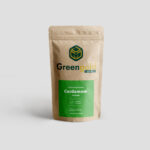Cardamom is a prized spice with a complex production process that affects its carbon footprint—the total amount of greenhouse gases (GHGs) emitted during its cultivation, processing, and transportation. While cardamom farming has both positive and negative environmental impacts, understanding these can help in making sustainable choices.
🔥 What Contributes to the Carbon Footprint of Cardamom?
⚠️ 1. Land Use and Deforestation
✔️ Some large-scale plantations clear forests, releasing stored carbon into the atmosphere.
✔️ Loss of tree cover reduces the ability to absorb CO₂.
✔️ Deforestation leads to soil degradation, which increases emissions.
💡 Solution! Shade-grown cardamom preserves forests, reducing the carbon footprint. 🌳🌎
🚜 2. Agricultural Practices & Soil Health
✔️ Chemical fertilizers release nitrous oxide (N₂O), a potent greenhouse gas.
✔️ Excessive tilling disturbs soil carbon storage, leading to emissions.
✔️ Overuse of pesticides harms beneficial soil microbes, reducing carbon sequestration.
💡 Solution! Organic farming methods, composting, and cover cropping help capture carbon and improve soil health. 🌱♻️
⚡ 3. Processing & Drying Cardamom
✔️ Cardamom pods are dried using wood-fired kilns or fossil fuel-powered dryers.
✔️ Traditional drying methods emit CO₂ and particulate matter.
✔️ Modern processing facilities require significant energy consumption.
💡 Solution! Switching to solar-powered drying systems or energy-efficient processing reduces emissions. ☀️🔥
🚢 4. Transportation & Global Supply Chains
✔️ Cardamom is a globally traded spice, often transported long distances.
✔️ Air freight emits high levels of CO₂ compared to sea or land transport.
✔️ Packaging materials also contribute to the overall carbon footprint.
💡 Solution! Supporting local and fair-trade sources reduces transport emissions and promotes sustainable packaging. 🚛📦
✅ How to Reduce Cardamom’s Carbon Footprint?
🔹 Support organic and shade-grown cardamom to protect forests.
🔹 Use renewable energy sources for drying and processing.
🔹 Encourage carbon-friendly packaging (biodegradable or reusable).
🔹 Choose locally sourced or sustainably farmed cardamom to reduce transport emissions.
🔹 Invest in carbon offset programs to balance out emissions from cardamom production.
🌱 Final Thoughts: Sustainable Cardamom for a Greener Future
While cardamom production does contribute to carbon emissions, sustainable farming practices can significantly reduce its impact. By choosing eco-friendly cardamom, we can enjoy this aromatic spice without harming the planet! 🌎💚












